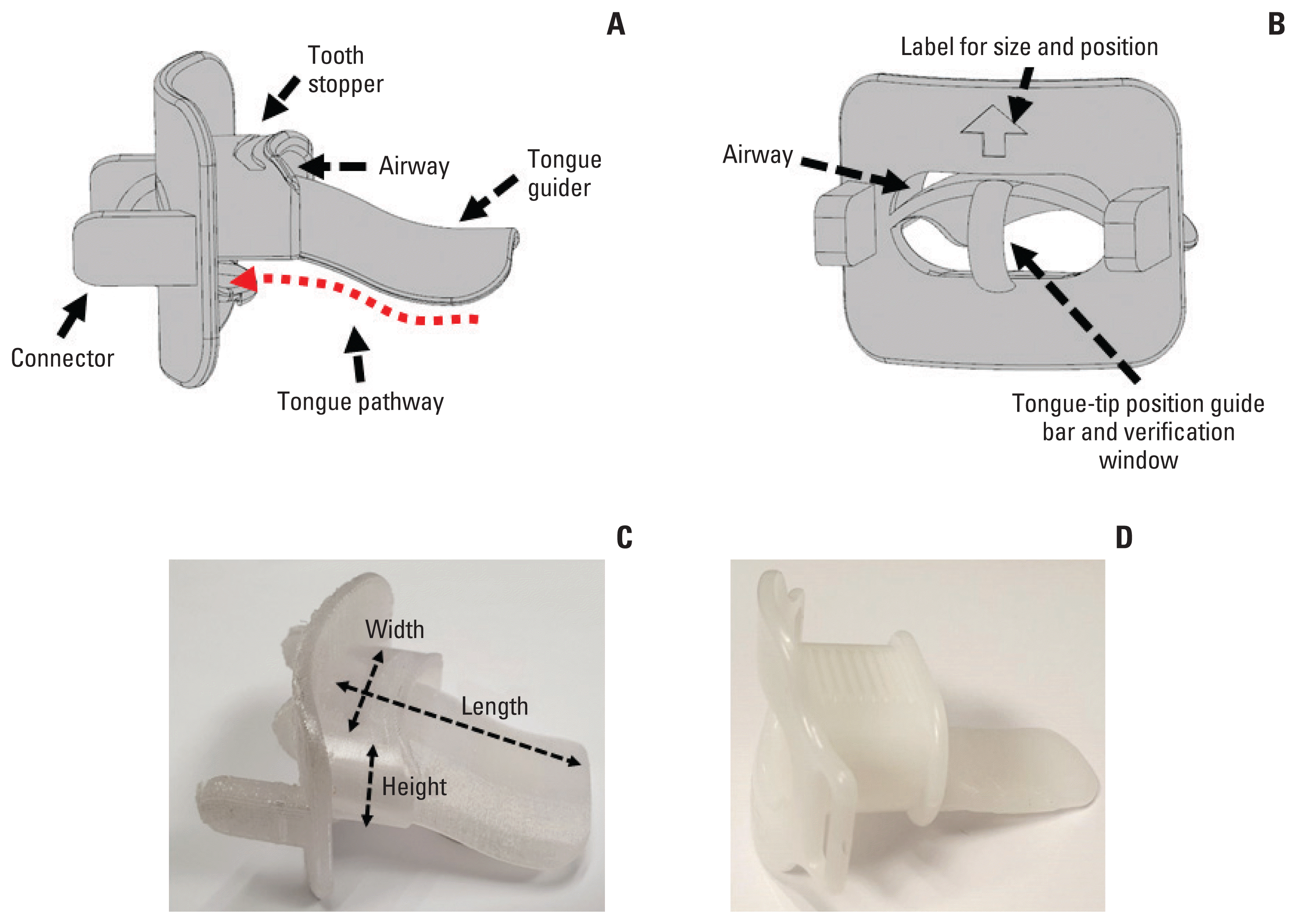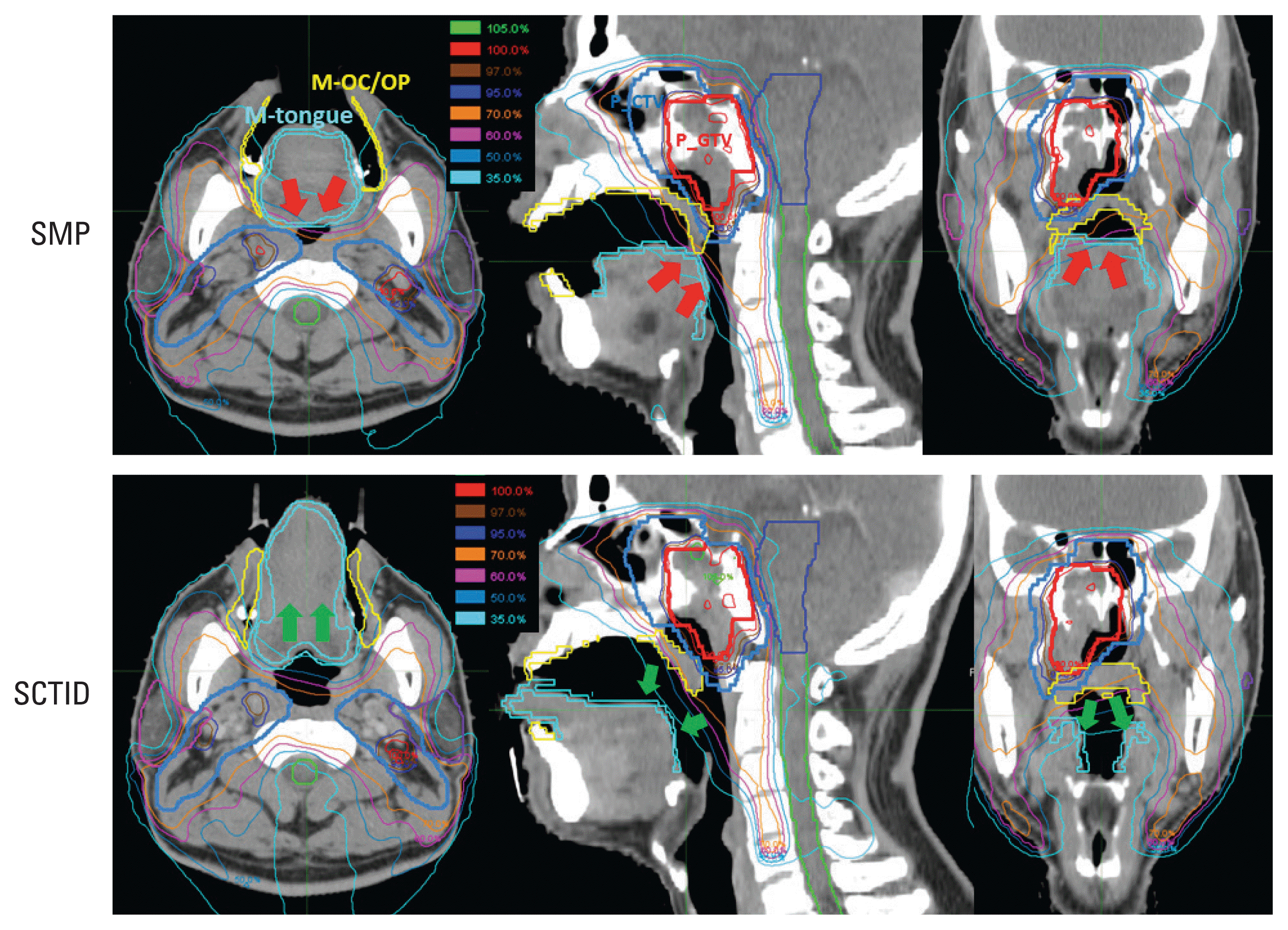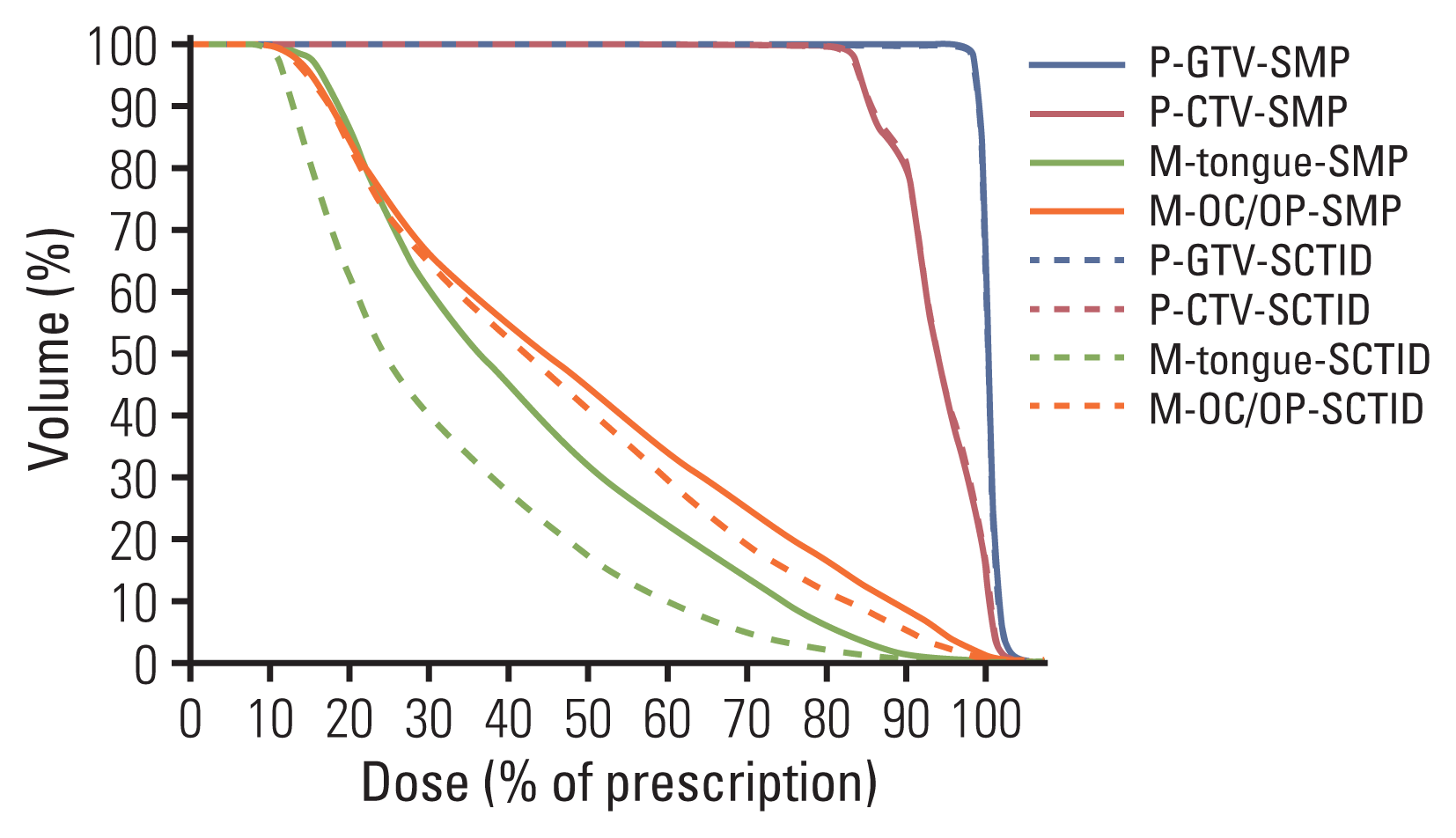Introduction
Materials and Methods
1. Patient selection
Table 1
2. Design of SCTID
 | Fig. 1Side (A) and front (B) views of the 3D model for the semi-customized tongue immobilization device. It was printed using a three-dimensional printer with a biocompatible material (C). Commercially available standard mouthpiece (D), which has been the most commonly used device in head and neck cancer radiation therapy. |
3. Simulation
4. Delineation of target volumes and OARs
5. Treatment planning
Table 2
| Priority | Structure | Constraints |
|---|---|---|
| 1 | P-GTV |
D95 ≥ 67.2 Gy (100%) D99 ≥ 95% of the prescribed dose (67.2 Gy) V73.9 (110%) ≤ 1 cm3 |
| P-CTV |
D95 ≥ 56.0 Gy (100%) D99 ≥ 95% of the prescribed dose (56.0 Gy [100%]) |
|
| P-corda) | Dmax ≤ 45.0 Gy | |
| 2 | Parotid | Dmean < 26.0 Gy |
| 3 | M-tongue and M-OC/OP |
Dmean < 30.0 Gy V30 < 30% |
| 4 | Brain stem | Dmax ≤ 54.0 Gy |
Dmax, maximum dose; Dmean, mean dose; DV, D dose delivered to V% of organ volume; M-OC/OP, mucosa of the oral cavity and oropharynx; M-tongue, mucosa of the tongue; P-cord, planning spinal cord; P-CTV, planning clinical target volume; P-GTV, planning gross target volume; VD, absolute or percentage of organ volume receiving D Gy or higher.
6. Evaluation of geometric and dosimetric effects of SCTID versus SMP
7. Setup reproducibility of the tongue with SCTID
Results
1. Geometrical effect of SCTID
 | Fig. 2Isodose distributions for the standard mouthpiece (SMP, upper) and semi-customized tongue immobilization device (SCTID plans, lower). The tongue was effectively stuck out along the tongue guider by using the SCTID, it led to displacement of the mucosa of the tongue (M-tongue) from target (green arrows) while a partial volume of the M-tongue received a high dose equivalent to the prescribed dose (red arrows) in the SMP plan because depression of tongue caused the tongue to push back toward posterior neck region. |
Table 3
| Parameter | M-Tongue | M-OC/OP | ||||
|---|---|---|---|---|---|---|
|
|
|
|||||
| SMP | SCTID | p-value | SMP | SCTID | p-value | |
| Volume (cm3) | 15.4±1.8 | 18.5±1.4 | 0.001a) | 43.8±9.0 | 46.3±17.3 | 0.659 |
|
|
||||||
| V15 (%) | 79.0±10.2 | 55.1±11.7 | 0.001a) | 79.3±7.9 | 77.4±6.6 | 0.482 |
|
|
||||||
| V30 (%) | 38.1±10.6 | 22.2±9.2 | 0.001a) | 49.7±9.8 | 46.9±9.6 | 0.359 |
|
|
||||||
| V45 (%) | 16.1±10.8 | 6.1±5.3 | 0.001a) | 27.3±10.2 | 21.7±8.6 | 0.035a) |
|
|
||||||
| V60 (%) | 1.0±1.1 | 0.3±0.9 | 0.074 | 8.8±6.6 | 5.3±5.0 | 0.012a) |
|
|
||||||
| Dmean (Gy) | 27.8±4.1 | 20.7±3.2 | 0.001a) | 32.4±4.5 | 30.5±3.7 | 0.105 |
|
|
||||||
| Dmax (Gy) | 60.1±5.9 | 56.6±6.0 | 0.037a) | 67.4±2.3 | 65.6±3.3 | 0.005a) |
Values are presented as mean±standard deviation. Dmax, maximum dose; Dmean, mean dose, M-OC/OP, the mucosa of the oral cavity and oropharynx; M-tongue, mucosa of the tongue; SCTID, semi-customized tongue immobilization device; SMP, standard mouthpiece; VD (15, 30, 45, and 60), the percentage of the tongue volume that received D (15, 30, 45, and 60) Gy or more.
2. Dosimetric comparison
 | Fig. 3Mean DVHs for mucosa of the tongue (M-tongue, green) and oral cavity and oropharynx (M-OC/OP, orange) dramatically decreased using a semi-customized tongue immobilization device (SCTID, dotted line) compared with standard mouthpiece (SMP, solid line), but mean DVHs for the targets showed almost same shape between two groups. M-OC/OP, mucosa of the oral cavity and oropharynx; M-tongue, mucosa of the tongue; P-cord, planning spinal cord; P-CTV, planning clinical target volume; P-GTV, planning gross target volume. |
Table 4
| Parameter | SMP | SCTID | p-value |
|---|---|---|---|
| P-GTV | |||
| D2% (Gy) | 68.7±0.5 | 68.9±0.6 | 0.087 |
| D98% (Gy) | 66.4±0.2 | 66.2±0.2 | 0.005a) |
| D50% (Gy) | 67.7±0.4 | 67.7±0.3 | 0.619 |
| HI | 0.035±0.1 | 0.039±0.1 | 0.011a) |
| CI | 0.7±0.1 | 0.7±0.1 | 0.380 |
| P-CTV | |||
| D2% (Gy) | 68.3±0.4 | 68.4±0.4 | 0.570 |
| D98% (Gy) | 58.5±2.2 | 58.4±2.5 | 0.430 |
| D50% (Gy) | 62.9±2.4 | 62.9±2.6 | 0.912 |
| HI | 0.2±0.1 | 0.2±0.1 | 0.286 |
| CI | 0.8±0.1 | 0.8±0.1 | 0.742 |
| Parotid glands | |||
| Dmean (Gy) | 30.8±3.9 | 30.7±3.0 | 0.779 |
| P-cord | |||
| Dmax (Gy) | 30.6±4.9 | 30.5±7.4 | 0.973 |
| Brainstem | |||
| Dmax (Gy) | 40.8±12.7 | 40.2±11.6 | 0.624 |
Values are presented as mean±standard deviation. CI, conformity index; Dmax, maximum dose, Dmean, mean dose; DV%, minimum dose received by 2% (D2%), 98% (D98%), and 50% (D50%) of the PTVs; HI, homogeneity index; OARs, organ at risks; P-cord, planning spinal cord; P-CTV, planning clinical target volume; P-GTV, planning gross target volume; SCTID, semi-customized tongue immobilization device; SMP, standard mouthpiece.
3. Setup reproducibility of the tongue with SCTID
 | Fig. 4In most patient, shape and position of the tongue in daily setup mega-voltage computed tomography (MVCT) image (red) matched well with original one in plan computed tomography image (grey) (A). (B) The mean accumulated-adaptive-DVH (AA-DVH) for tongue (orange dotted line) was almost in line with the mean planned DVH (P-DVH) for tongue (blue solid line), while the mean AA-DVH for tongue base (green dotted line) was slightly higher than the mean P-DVH for tongue base (red solid line), but no significant differences was observed between two groups (p > 0.05). |




 PDF
PDF Citation
Citation Print
Print


 XML Download
XML Download